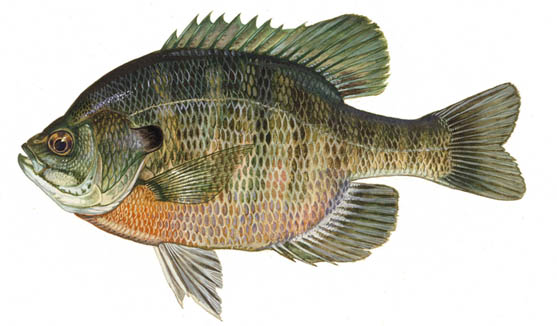
Lepomis macrochirus
Bream, sun perch, blue sunfish, copperbelly
Bluegills may be distinguished from other sunfish by the dark spot at the base of the dorsal fin and the solid black gill flap. They also have 6-8 vertical bars on their sides, and a relatively small mouth. The spiny dorsal fin usually has 10 spines and is broadly connected to the soft dorsal. The anal fin has three spines.
Small mouth size limits the size of food particles ingested and almost dictates a diet of insects and similar small organisms. While insects remain the staple food item for adults, crayfish, snails, small fish, and fish eggs are also consumed.
Bluegills appear to have been native to the eastern half of the United States, southeastern Canada and northeastern Mexico. Today, as a result of countless intentional introductions, bluegill are found throughout the US and northern Mexico.
The bluegill enjoys warm, shallow lakes with rooted vegetation. During mid-day, they go to deeper waters of shallow lakes or beneath the shade of trees or brush.
An adult bluegill can reach a size of about 12 inches in length although the average is 8 inches. A good size bluegill can reach 2 pounds in size. They live an average of 4-6 years.
4 pounds, 12 ounces (Source - IGFA)